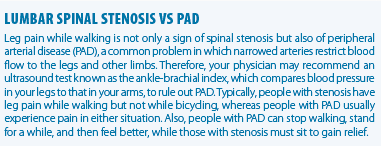Do You Lean on Your Shopping Cart?
Spinal stenosis can cause pain in the legs and/or the lower back when walking, and that pain it is often relieved by leaning forward. That’s why some people lean on a cart while shopping. Spinal stenosis refers to narrowing of the spinal canal or the spaces where nerves exit the spinal canal. As the spaces narrow, the nerve roots passing through those spaces can be compressed, causing pain, numbness, and weakness.
“The narrowing can occur when vertebral discs or joints degenerate,” explains physical therapist Daniel Salazar, DPT, UCLA Medical Center, Santa Monica. “There also can be excessive growth of bone spurs from overloading the joints, which, in turn, can lead to more narrowing.”
Trauma from a mechanical force (a car accident for example) also can narrow the spaces where nerves travel. However, age-related degeneration is the most common reason why people ages 65 and older experience this condition.
Spinal stenosis can occur anywhere along the spine, but it most often occurs in the lumbar spine. Since the lumbar nerves extend down the legs to the toes, spinal stenosis causes numbness, tingling, weakness/heaviness, or pain in the back, legs, and buttocks.
Diagnosing Spinal Stenosis
Diagnosis involves a detailed history of symptoms and a physical exam, with a focus on testing for sensation, motor strength, reflexes, and assessing how you walk. It’s possible to have signs of stenosis visible on imaging scans without any symptoms. In other words, you can have some narrowing but no pain. That’s why imaging (usually magnetic resonance imaging [MRI]) should only be used to confirm a suspicion of spinal stenosis derived from a medical history and physical exam.
Prevention and Risk Factors
Spinal stenosis is common with aging but it’s difficult to know who will actually  develop symptoms. The good news is that in most cases, the degenerative process can be somewhat controlled by changes in lifestyle.
develop symptoms. The good news is that in most cases, the degenerative process can be somewhat controlled by changes in lifestyle.
“Being overweight, especially for people who carry most of the weight in the stomach area, creates muscle imbalances between the front and back of the body,” explains Salazar. “The spinal muscles in the back have to work harder against gravity, and this overloads the spine.”
It’s simple to say just lose weight, but it can be a challenge to achieve. Many people do best when they have support. Being held accountable through support groups or partnering with someone else who’d like to lose weight helps many people succeed. It’s also helpful to consult with a registered dietitian, who can develop an eating plan that’s realistic for you.
Treatment Protocols
The general protocol for treating back pain typically starts with nonsteroidal anti-inflammatory drugs (NSAIDs) and physical therapy followed by interventional pain management strategies for persistent pain (e.g., anesthetic and steroid injections). Surgical intervention is the last resort. When it comes to exercise for spinal stenosis, physical therapists will conduct a thorough assessment to determine where your muscular imbalances are and how to correct them safely and effectively. According to Salazar, a lack of core strength or weakness (which involves the abdominals, pelvic floor, diaphragm, and smaller back muscles) places bigger demands on the back extensors. Another area of focus is posture.
“Many people have poor postural awareness when standing, walking, and sitting and often sustain postures with too much lumbar extension,” says Salazar. “Incorrect lifting, which often involves lumbar extension, also can overload the spine and worsen stenosis.”
Exercise can help you feel better quickly, sometimes during a single session. But regular exercise is essential to staving off further damage and maintaining muscular strength.
Research shows that most people with pain from spinal stenosis successfully manage the condition without the need for surgery.
The post Do You Lean on Your Shopping Cart? appeared first on University Health News.

